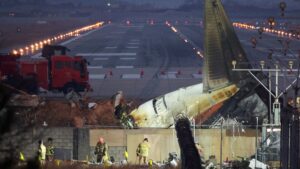Analyzing the Tragic Jeju Air Flight Incident: A Deep Dive into Aviation Safety
At Extreme Investor Network, we understand that tragic events can have far-reaching implications, not only in human lives but also in the aviation industry as a whole. The recent crash of Jeju Air Flight 7C2216 on December 30, 2024, at Muan International Airport has been a stark reminder of the vulnerabilities that exist in flight operations and airport safety. With all but two of the 181 passengers on board losing their lives, this incident has raised significant questions among aviation experts regarding airport design and safety protocols.
A Closer Look at the Accident
The Boeing 737-800, operated by Jeju Air, attempted a landing following an overnight flight and tragically belly-landed on the runway. Eyewitness accounts and footage from the scene indicated that the aircraft was seen skidding before colliding with a mound of dirt and a concrete wall situated just past the runway. The moment the aircraft made contact with the wall, it burst into flames, leading to catastrophic consequences.
Todd Curtis, founder of Air Safe Media and a former Boeing safety engineer, emphasized the challenges posed by the airport’s design. "Certainly that made it difficult to stop the aircraft safely," he noted, highlighting how the architecture of the airport might have compromised the safety of this landing.
Investigation Insights
The investigation into this tragedy is expected to be lengthy and exhaustive. Authorities will examine all potential factors, from aircraft maintenance logs to cockpit voice recordings. Although initial speculations suggest that a bird strike may have been a contributing factor to a potential engine failure, experts are quick to underscore the complexities involved in uncovering the full picture.
The presence of a concrete wall at the end of the runway raises critical questions about safety measures in place for steering aircraft back onto a safe path in case of landing mishaps. Many airports worldwide have adopted engineered material arresting systems (EMAS)—a crushable material designed to slow down vehicles that overrun runways—aiming to prevent such catastrophes from occurring. Why didn’t Muan International Airport invest in similar safety measures? This remains a pivotal question that investigators will likely explore further.
Redefining Airport Safety Standards
It’s crucial to recognize that while barriers past runway ends can be essential—helping divert aircraft away from dangerous areas—these barriers must be designed to ensure they do not contribute to fatal incidents. Reports suggest the barrier at Muan did not appear to be "frangible," meaning it lacked the ability to break away upon impact, potentially exacerbating the crash’s severity.
As stakeholders in the aviation industry, both from operational and investment perspectives, we must prioritize and advocate for more robust safety frameworks. Enhancing regulations around airport design, runway barriers, and emergency response protocols should be at the forefront of discussions among regulators, airport operators, and airlines.
Lessons for Investors and Stakeholders
For investors and stakeholders monitoring the aviation sector, it is essential to recognize the broader implications of this event. Not only does it underscore the immediate human tragedy, but it also serves as a stark reminder of the importance of infrastructure resilience and the rigorous assessment of operational risks in aviation.
As the investigation unfolds, here are a few key takeaways that could impact future investments in the aviation sector:
-
Increased Demand for Safety Technologies: There will likely be renewed investment in safety technologies and designs that prioritize incident prevention.
-
Policy Changes: Anticipate potential changes in regulations governing airport designs and safety measures, which could influence operational costs and practices in the long term.
- Market Reactions: Companies involved in aviation safety technology may see fluctuations in stock prices as the industry reassesses the implications of this tragic event.
At Extreme Investor Network, we will continue to monitor developments in this area closely and provide our audience with insights that will empower them to make informed decisions. The Jeju Air incident serves as a sobering reminder of our industry’s vulnerabilities, urging us to push for a safer and more accountable aviation environment.

